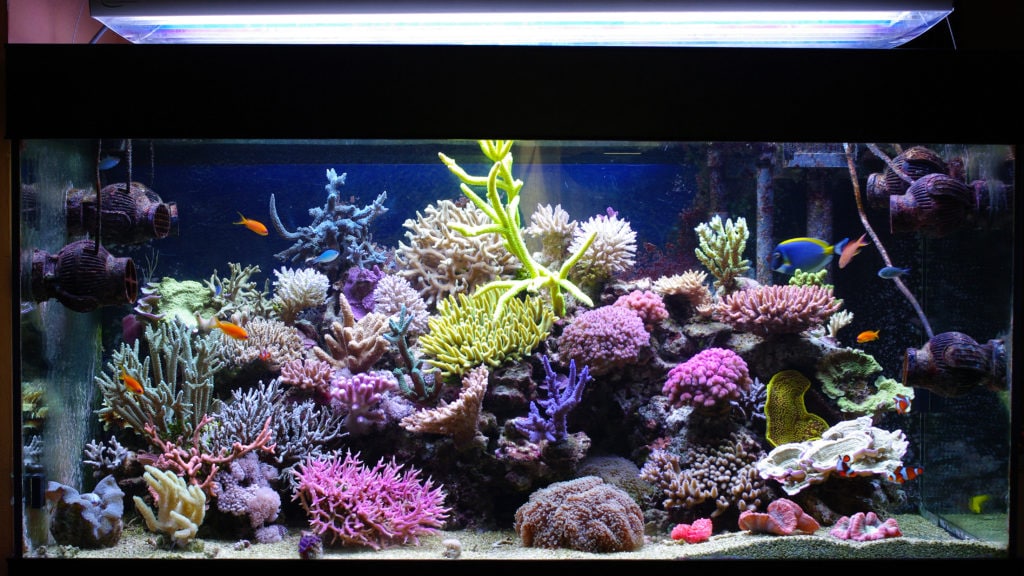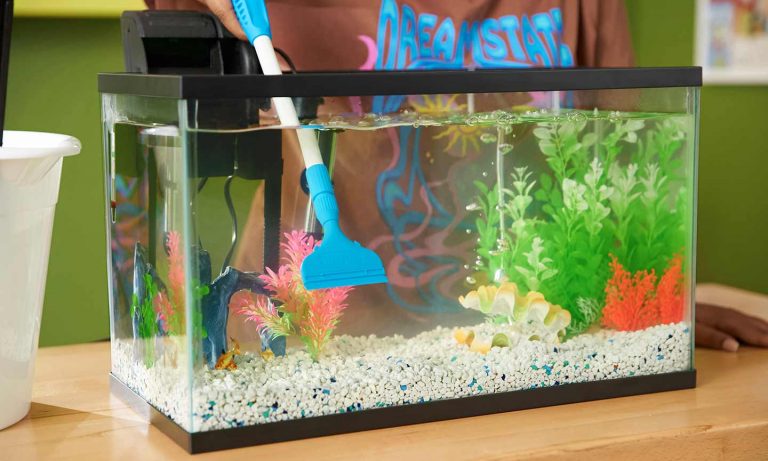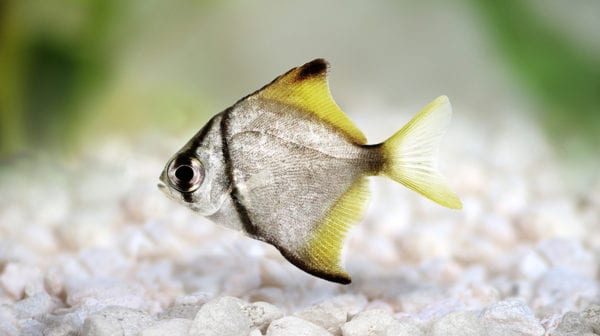With marine aquariums, the bigger the tank and setup, the more expensive it is to put together. As a matter of fact, during the many years that I owned and operated my local fish stores here in the greater Boston area, it really seemed to me that one of the goals of some hobbyists was to see how big they could make their marine tank and how much money they could spend. One customer had a 220-gallon tank and was always buying the latest fish tank accessories; this was before the Internet, and therefore, he usually bought the stuff from me. He would not, however, invest less than $100 in a quarantine tank, even though I constantly urged him to do so. Yes, he bought a fish someplace and put it right into his tank, and he wiped out thousands of dollars worth of fish and invertebrates.
But I digress. The purpose of this article is to talk about how it is possible to do a marine aquarium on a budget, how you can enjoy the marine side of our hobby without having to take out a second mortgage on your house. The equipment for keeping marine fish has become very effective and simple to use. We know much more about keeping smaller marine tanks than we did even 5 years ago, and most important, there are a wide variety of commercially bred fish and invertebrates that are easier to keep than anything taken from the wild. In this article, I will discuss some basic rules for putting together an affordable marine fish aquarium, and I will suggest a few different types of tanks that will give you the pleasure of keeping marine fish and invertebrates without breaking the bank. I will also comment on the best fish and invertebrates for these aquariums.
Size Matters
There are a few general considerations for having a successful marine aquarium on a limited budget. While working on this article, I had a long chat with my good friend, Allen Fefferman, who owns and operates Old Orchard Aquarium in Skokie, Ill. Allen has one of the best local fish stores in the country, and he understands the various aspects of aquariums as well as anyone I know.
The primary consideration when doing a marine aquarium with limited funds is that you really do need to keep the tank a modest size. It is difficult to set an upper size limit for what is “affordable,” but the costs really do start skyrocketing once you get over 30 gallons. Also, in keeping with a smaller size, you will save money if you start with a tank that can be kept on a table, desk or other existing flat surface; having to purchase a stand adds a fair amount to the total cost of a setup. Allen remarked that if you spend less money on the equipment, you will have to spend more time taking care of the fish, and this does make sense. This, however, is probably a very good thing. In general, the more attention hobbyists pay to their fish, the healthier their fish will usually be, as long as the extra attention is not in the form of feeding too much. The marine aquarium on a budget can be as simple as a 20-gallon tank with a hang-on-back outside fish tank filter, a heater and marine substrate. This would make a fine home for a couple of clownfish, some shrimp and a hermit crab. The bigger expenses of a marine tank really start adding up as you increase in size and want to keep marine animals that require high-intensity lighting. For a marine tank on a budget, large fish and all but a few corals are not in the picture.
Livestock Selection
This brings us to the second factor for having a successful marine aquarium on a budget: Stick to fish and invertebrates that have been commercially aquacultured. Don’t buy anything that has been caught in the wild and brought into the local fish store. While this may seem limiting, by setting a budget for this marine tank, you limit yourself to a small tank, and you don’t want fish that get too large. There are a nice variety of clownfish, gobies, dottybacks and other small marine fish that are commercially farmed today, and the varieties keep increasing. Commercially raised marine fish have a number of advantages—they are used to being with other fish, they are usually free of the many parasites that can come on wild fish, and they are accustomed to eating the available prepared foods. They are also usually reasonably priced—well within the modest budget we are talking about.
The other important keys to success with a small marine tank all involve simple stocking and maintenance considerations. Of first importance is that you do not crowd the tank with fish. Please remember, the fish you will be buying (all of which will, I trust, be commercially farmed) are juveniles; this must be taken into consideration when stocking a tank. The commercially raised clownfish offered for sale at your local fish store will usually be 1 to 2 inches in size. Their adult size will be more than twice that. Don’t put too many fish in the tank.
A second consideration is that you not overfeed the fish. Fish always look like they are starving, and they very quickly learn to recognize what I like to call the “flake-food fairy,” who comes on a regular basis and drops food in their tank. The temptation is to do this whenever you see the fish begging for food – which will be always. Proper feeding is a tiny amount of food, three or four times a day. Always make sure that the fish are eating every bit of the food you put in there within a minute or two. Fish can go for many days without food and be just fine; many more fish have died from overfeeding than from underfeeding. Commercially raised marine fish will have been fed many times a day, but the commercial fish farmers feeding their fish on a large fish farm are very different from when you feed your couple of fish in a small tank. Overfeeding is probably the cause of most problems with fish, especially with beginner hobbyists, be they with freshwater or salt.
The most important key to success, especially with a small marine tank, is water changes. Regular, partial water changes are crucial to the health of any aquarium and more so the smaller the tank. In a smaller amount of water, water quality can deteriorate easily and quickly, resulting in problems for the tank inhabitants. Regular (once a week if possible) partial (20 percent or so) water changes are imperative. One store that I know will not sell a small marine tank (at least to a beginner) unless they also buy 5 gallons of saltwater. They give away the 5-gallon container and either sell it filled with salt water or include 5 gallons of salt water mix with the sale. Without regular partial water changes, many small marine tanks fail.
Budget Marine Tank Options
Nano Tanks
Nano tanks have become very popular, and there is a wide variety available at any local fish store. For the purposes of this discussion, I will use the term “nano tank” to mean a tank less than 12 gallons. These usually come as a complete kit, with the light and cover matching the tank, and a filter built into the rear of the tank. The only problem with many nano tanks is that they often do not come with a heater. It is not difficult to add a small heater to a nano tank, and I think it is chancy to use a nano tank for a marine aquarium without one. Many local fish stores have at least one marine fish nano tank on their counter. Some stores offer a variety of nano tanks, ones that they have set up and have on display, for direct sale “as is.” They simply put the fish and invertebrates into containers, put the water into a 5 gallon jug(s), and the happy customer walks out with the tank and reassembles everything at their home or office. Because of their small size, nano tanks are usually very affordable, and they will do well for a long time as long as you don’t overfeed and you religiously perform water changes. I have two nano tanks here on my desk, and for a few years, one of them had a very happy peacock mantis shrimp. The other one was home to a nice clownfish and some other shrimps for a long time. A nano tank can make a very economical and interesting aquarium–without costing much at all.
Freshwater Starter Tank
Just Add Salt and Substrate. While most of my friends who own and operate local fish stores don’t really like to hear me say this, you can use a typical 20-gallon freshwater starter kit and easily convert it to a marine tank. This can be done at a minimal cost; all you really need to do is remove the freshwater gravel and replace it with a marine substrate (dolomite, crushed coral or the like), and add the required amount of salt mix. You will also need a hydrometer to monitor the salinity so it is kept at the correct level. Converting a starter freshwater tank to marine you also need to be careful to keep the salt from building up on the light. You may, in fact, want to invest in a glass cover for the tank and put the light on the glass cover.
Marine Kits
There are now a number of different complete marine starter kits available, and the size you select will depend on the size of your budget. Marine starter kits are definitely more expensive than a nano tank or converting a freshwater starter kit to marine, but they are available in larger sizes (up to our somewhat-arbitrary, 30-gallon limit), and they usually include everything you need, neatly packaged into the tank itself. Most of the better manufacturers include a complete system of filtration and protein skimming concealed at the back of the tank. This allows for your view of the fish to be unobstructed with any filters or heaters. The kit is designed so that the water flows through all of the equipment in the back section, which is not visible when you are looking at the front. As the engineering and design of aquariums has advanced (which often involves bringing products used in Europe, especially Italy and Germany, to the United States), the complete marine kits have improved greatly. Depending on what your idea of a “budget” is, you can get some very beautiful and sophisticated packages.
Fish and Invertebrates
In keeping with our idea of a marine aquarium on a budget, we have pointed out that the size of the budget will pretty much dictate the size of the tank. And the size of the tank will limit the size of the fish we can keep and the numbers. It is impossible to stress this enough: Stay with small fish and don’t crowd them. Equally important is that you need to stay with fish that have been commercially produced. To get a good idea of some of the fish that are being commercially produced, you may want to take a look at the websites of some of the leading producers of farmed marine fish in the U.S. These include:
I apologize if I have offended anyone by not including them in the above; these three companies are the ones I have known best for many years.
Commercially produced marine fish that are ideal for a budget aquarium include clownfish, dottybacks, blennies, gobies, assessors, cardinals and dragonets, as well as a variety of seahorses. In response to some questions that I am sure are being asked: No, there are no clown triggers, Koran angelfish or copperbanded butterflies being commercially produced, and they are much too large for any tank on a budget. With just clownfish and gobies, there are plenty of beautiful marine fish for any tank, and their cost will not bust the budget.
Our budget marine aquarium can also include some invertebrates, but they should also only be creatures that have been commercially produced. There is a nice assortment of both hard and soft corals being farmed these days, but given that part of the budget limitation of our tank is that we will only have standard aquarium lighting, we are limited in terms of what we could include for corals. All hard corals are out of the question, but some of the easier soft corals, such as mushrooms, Xenia spp. and Zooanthids, are possible. The problem is space, as these soft corals will grow quickly, and you have to be prepared to trim them back or swap them out for smaller specimens. Also included in the budget tank should be a nice small assortment of snails, shrimps and hermit crabs, most of which are also being commercially produced (with the exception of hermit crabs). The other problem, especially with shrimp, is that they can be very territorial; therefore, you may be able to keep only one or two in the budget tank.
Budget-Savvy Results
Hopefully, I have put forth the argument that a basic marine aquarium on a budget is possible and convinced you to give one a try. If you stay with aquacultured fish and invertebrates, don’t crowd the fish and don’t overfeed them, the tank should do very well. Most important of all – do those regular partial water changes. When you decide you want to try a marine tank on a budget, please go to one of your local fish stores. The prices on the Internet may be lower, but nothing can replace the guidance and assistance you will get at your local store. My friend, Allen Fefferman, of Old Orchard Aquarium says, “I want to interact with my customers in a way that they are successful with their fish.” This feeling is shared by all good local fish stores. They are in the business because they love the aquarium hobby, and they want nothing more than to help you to succeed. Allen also points out that you can always convert that 20-gallon, first marine aquarium to freshwater and move on up to larger marine tanks.
By: David A. Lass
Featured Image: Dobermaraner/Shutterstock
Share:









